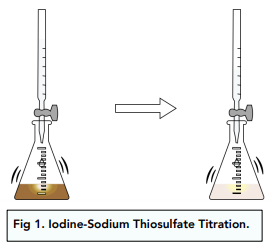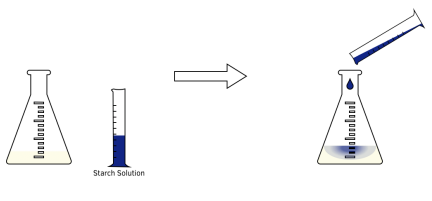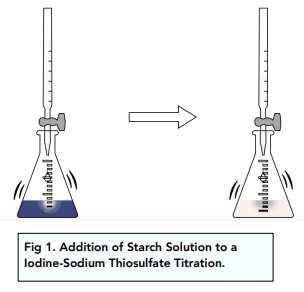Transition Metals - Iodine-Sodium Thiosulfate Titrations (A-Level Chemistry)
Carrying out a Iodine-Sodium Thiosulfate Titrations
In order to find out the concentration of an oxidising agent, Iodine-Sodium Thiosulfate titrations can be used.
This involves adding an acidified solution of potassium iodide (KI) to a solution of the oxidising agent under investigation. The iodide ions in solution will be oxidised to iodine:
I2 + 2e⁻ ⇌ 2I⁻
For example, if we were using potassium iodate (V) (KIO₃) as the oxidising agent, the reaction would be:
IO₃⁻ (aq) + 2I⁻ (aq) + 6H⁺ (aq) → 3I₂ (aq) + 3H₂O (l)
The higher the concentration of the oxidising agent, the more iodide ions will be oxidised to iodine.
In order to find out how many moles of iodine have been produced, the solution is titrated with a solution of sodium thiosulfate (Na₂S₂O₃) of known concentration. Iodine will react with the thiosulfate ions to form iodide ions once again, turning the solution from brown to colourless:
I₂ (aq) + 2S₂O₃²⁻ (aq) → 2I⁻ (aq) + 2S₄O₆²⁻ (aq)

As the thiosulfate solution is added from the burette drop by drop, the iodine solution in the conical flask will gradually become a very pale yellow as the end point is approached. The end point of the titration can therefore be difficult to see.
If we add 2cm³ of starch solution, the reaction mixture will turn dark blue to indicate that iodine is still present. Now you can continue to add sodium thiosulfate drop by drop until the blue colour disappears completely, indicating that all the iodine has just reacted.


Calculating the Concentration of the Oxidising Agent
In order to find out the concentration of an oxidising agent, we have to carry out two simple stoichiometric calculations.
Worked example: A student adds 25.0 cm³ of potassium iodate (V) solution to an excess of acidified potassium iodide solution. He then titres the resulting solution with 0.120 mol dm-³ sodium thiosulfate solution. It takes 11.0 cm³ of sodium thiosulfate solution to reach the end point in the titration.
Calculate the concentration of potassium iodate. (4 marks)
Answer
Step 1: Calculate the number of moles of sodium thiosulfate added in the titration.
Number of moles = concentration x volume
Number of moles = [0.120 mol dm⁻³ x 11.0 cm³]/1000 = 1.32 x 10⁻³ mol
Step 2: Calculate the number of moles of iodine that have reacted in the titration.
For this use the stoichiometry of the equation:
I₂ (aq) + 2S₂O₃²⁻ (aq) → 2I⁻ (aq) + 2S₄O₆²⁻ (aq)
2 moles of thiosulfate ions are used per mole of iodine (Ratio 2:1)
Therefore, if moles of thiosulfate = 1.32 x 10⁻³ mol
Then moles of iodine = 1.32 x 10⁻³ mol / 2 = 6.60 x 10⁻⁴ mol
Step 3: Calculate the number of moles of oxidising agent.
For this use the stoichiometry of the equation:
IO₃⁻ (aq) + 2I⁻ (aq) + 6H⁺ (aq) → 3I₂ (aq) + 3H₂O (l)
3 moles of iodine are produced for every mole of iodate ions (Ratio 3:1)
Therefore, if moles of iodine = 6.60 x 10⁻⁴ mol
Then moles of iodate = 6.60 x 10⁻⁴ mol / 3 = 2.20 x 10⁻⁴ mol
Step 4: Calculate the concentration of oxidising agent.
Number of moles = concentration x volume
Concentration = number of moles / volume
Concentration= (2.20 x 10⁻⁴ mol / 25.0cm³) x 1000 = 0.00880 mol dm⁻³
Iodine-Sodium Thiosulfate Titration with Copper (II) ions
An alloy is the combination of metals with other metals or elements.
An iodine-sodium thiosulfate titration can be used to calculate the percentage composition of copper metal in an alloy such as brass. The titration goes as follows:
1. Prepare a a solution of the alloy. A known mass of the alloy is first dissolved in concentrated nitric acid and the mixture made up to 250cm³ by adding deionised water. 25cm³ of the mixture is pipetted into a separate conical flask. Sodium carbonate solution is then slowly added until a white precipitate forms, indicating that any leftover acid has been neutralised. The precipitate can be removed by adding a bit of ethanoic acid.
2. Add an excess of potassium iodide solution. The iodide ions will reduce copper(II) ions in solution to copper (I) ions, forming a wash-off white precipitate of copper (I) iodide.
2Cu²⁺ (aq) + 4I⁻ (aq) → 2CuI (s) + I₂ (aq)
3. Titrate the resulting mixture with sodium thiosulfate solution. Fill a burette with sodium thiosulfate solution of known concentration and add it to the alloy mixture drop by drop until all of the iodine has reacted.
4. Calculate the percentage of copper in the alloy. The number of moles of copper can be calculated from the stoichiometric ratio of Cu²⁺ to I₂ derived from the reaction equation. This can then be used to calculate the mass of copper contained in the alloy sample used and hence its percentage composition.
Transition metals are elements in the periodic table that have partially filled d orbitals in their valence electron shells. They have unique physical and chemical properties that make them useful in various industries and applications.
An Iodine-Sodium Thiosulfate Titration is a laboratory experiment used to determine the amount of iodine present in a sample. Sodium Thiosulfate is used as the titrant, and iodine reacts with it to produce a yellow color. The reaction is monitored until the color disappears, which indicates the end point of the titration. The volume of Sodium Thiosulfate used is then used to calculate the amount of iodine in the sample.
The steps involved in an Iodine-Sodium Thiosulfate Titration are:
1. Preparation of the iodine solution: A known volume of iodine is dissolved in a solvent to make the solution to be titrated.
2. Preparation of the sodium thiosulfate solution: Sodium Thiosulfate is dissolved in water to make a solution that will be used as the titrant.
3. Titration of the iodine solution: A few drops of starch are added to the iodine solution. The sodium thiosulfate solution is then slowly added to the iodine solution while stirring. The reaction produces a yellow color, which disappears when the end point is reached.
4. Calculation of the amount of iodine: The volume of sodium thiosulfate used at the end point is recorded and used to calculate the amount of iodine in the sample.
Starch is used in an Iodine-Sodium Thiosulfate Titration as an indicator to indicate the end point of the reaction. When starch is added to the iodine solution, it reacts with iodine to form a blue-black complex. The appearance of the blue-black color indicates the end point of the titration.
The accuracy of an Iodine-Sodium Thiosulfate Titration can be determined by repeating the experiment several times and calculating the average value. The deviation of the values obtained from the average can be used to determine the accuracy of the experiment. Additionally, the use of a standardized sodium thiosulfate solution can also improve the accuracy of the experiment.
Iodine-Sodium Thiosulfate Titrations are commonly used in analytical chemistry to determine the amount of iodine in a sample. The method is widely used in various industries, such as water treatment, agriculture, and food science, to monitor the levels of iodine in water, soil, and food samples.






Still got a question? Leave a comment
Leave a comment